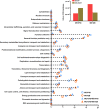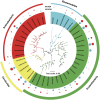Comparative shotgun metagenomic data of the silkworm Bombyx mori gut microbiome
- PMID: 30532085
- PMCID: PMC6289112
- DOI: 10.1038/sdata.2018.285
Comparative shotgun metagenomic data of the silkworm Bombyx mori gut microbiome
Abstract
Lepidoptera (butterflies and moths) is a major insect order including important pollinators and agricultural pests, however their microbiomes are little studied. Here, using next-generation sequencing (NGS)-based shotgun metagenomics, we characterize both the biodiversity and functional potential of gut microbiota of a lepidopteran model insect, the silkworm Bombyx mori. Two metagenomes, including the standard inbred strain Dazao (P50) and an improved hybrid strain Qiufeng × Baiyu (QB) widely used in commercial silk production, were generated, containing 45,505,084 and 69,127,002 raw reads, respectively. Taxonomic analysis revealed that a total of 663 bacterial species were identified in P50 silkworms, while 322 unique species in QB silkworms. Notably, Enterobacter, Acinetobacter and Enterococcus were dominated in both strains. The further functional annotation was performed by both BlastP and MG-RAST against various databases including Nr, COG, KEGG, CAZy and SignalP, which revealed >5 × 106 protein-coding genes. These datasets not only provide first insights into all bacterial genes in silkworm guts, but also help to generate hypotheses for subsequently testing functional traits of gut microbiota in an important insect group.
Conflict of interest statement
The authors declare no competing interests.
Figures



Similar articles
-
Contrasting gut bacteriomes unveiled between wild Antheraea assamensis Helfer (Lepidoptera: Saturniidae) and domesticated Bombyx mori L. (Lepidoptera: Bombycidae) silkworms.Mol Biol Rep. 2024 May 22;51(1):666. doi: 10.1007/s11033-024-09629-9. Mol Biol Rep. 2024. PMID: 38777963
-
Identification of Potential Probiotics in the Midgut of Mulberry Silkworm, Bombyx mori Through Metagenomic Approach.Probiotics Antimicrob Proteins. 2020 Jun;12(2):635-640. doi: 10.1007/s12602-019-09580-3. Probiotics Antimicrob Proteins. 2020. PMID: 31401774
-
Gut bacterial and fungal communities of the domesticated silkworm (Bombyx mori) and wild mulberry-feeding relatives.ISME J. 2018 Sep;12(9):2252-2262. doi: 10.1038/s41396-018-0174-1. Epub 2018 Jun 12. ISME J. 2018. PMID: 29895989 Free PMC article.
-
Advanced technologies for genetically manipulating the silkworm Bombyx mori, a model Lepidopteran insect.Proc Biol Sci. 2015 Jul 7;282(1810):20150487. doi: 10.1098/rspb.2015.0487. Proc Biol Sci. 2015. PMID: 26108630 Free PMC article. Review.
-
The progress and future of enhancing antiviral capacity by transgenic technology in the silkworm Bombyx mori.Insect Biochem Mol Biol. 2014 May;48:1-7. doi: 10.1016/j.ibmb.2014.02.003. Epub 2014 Feb 20. Insect Biochem Mol Biol. 2014. PMID: 24561307 Review.
Cited by
-
Dynamic Alterations of the Intestinal Microbiota of Fifth-Instar Silkworms (Bombyx mori) Fed an Artificial Diet or Mulberry Leaves.Insects. 2024 Dec 5;15(12):970. doi: 10.3390/insects15120970. Insects. 2024. PMID: 39769572 Free PMC article.
-
A comprehensive cell atlas of fall armyworm (Spodoptera frugiperda) larval gut and fat body via snRNA-Seq.Sci Data. 2025 Feb 12;12(1):250. doi: 10.1038/s41597-025-04520-z. Sci Data. 2025. PMID: 39939604 Free PMC article.
-
Enterococci as Dominant Xylose Utilizing Lactic Acid Bacteria in Eri Silkworm Midgut and the Potential Use of Enterococcus hirae as Probiotic for Eri Culture.Insects. 2022 Jan 27;13(2):136. doi: 10.3390/insects13020136. Insects. 2022. PMID: 35206710 Free PMC article.
-
The Role of Feeding Characteristics in Shaping Gut Microbiota Composition and Function of Ensifera (Orthoptera).Insects. 2022 Aug 10;13(8):719. doi: 10.3390/insects13080719. Insects. 2022. PMID: 36005344 Free PMC article.
-
Composition and Diversity of Gut Bacteria Associated with the Eri Silk Moth, Samia ricini, (Lepidoptera: Saturniidae) as Revealed by Culture-Dependent and Metagenomics Analysis.J Microbiol Biotechnol. 2020 Sep 28;30(9):1367-1378. doi: 10.4014/jmb.2002.02055. J Microbiol Biotechnol. 2020. PMID: 32522967 Free PMC article.
References
Data Citations
-
- 2017. NCBI Sequence Read Archive. SRX3209014
-
- 2017. NCBI Sequence Read Archive. SRX3207342
-
- 2018. NCBI Sequence Read Archive. SRX4519345
-
- 2018. NCBI Sequence Read Archive. SRX4515224
-
- Chen B., et al. . 2018. figshare. https://doi.org/10.6084/m9.figshare.c.4249433.v1 - DOI
References
Publication types
MeSH terms
Associated data
LinkOut - more resources
Full Text Sources
Research Materials

